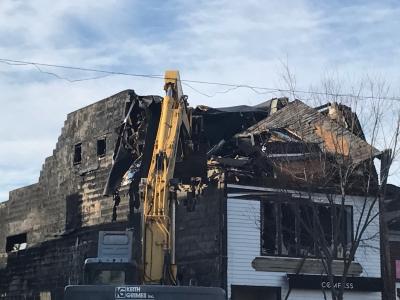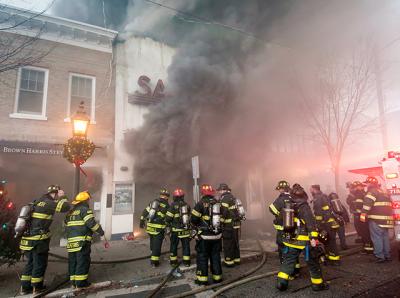Another Building Demolished on Sag Harbor's Main Street
Another Building Demolished on Sag Harbor's Main Street

A second building destroyed by a fire that ripped through five Main Street buildings in Sag Harbor on Friday has been demolished.
On Monday afternoon, workers turned heavy equipment on a building that housed the Compass real estate agency at 84 Main Street. Its structural integrity had been compromised in Friday's blaze. Flames had been first seen on the deck of an apartment on the second-story of the building at about 6:10 a.m. One apartment was evacauted. No one was hurt.
A three-story building, it was directly to the north of the Sag Harbor Cinema, which was demolished Friday night. The cinema lobby's roof collapsed as firefighters tried to extinguish the fire and the facade of the building, with its iconic neon "Sag Harbor" sign, was separated from the rest of the structure and was in danger of immediate collapse. Keith Grimes Inc., which the village contracted to conduct all the demolition work, was able to salvage the sign, a replica of the original.
The cinema's seating and screen are in a separate section behind the Compass building; it sustained heavy smoke and water damage but remained standing.
Village officials have no plans to immediately demolish any other buildings, they said on Monday. Three others were heavily damaged in the fire, closing businesses that included Sagtown Coffee, the Collette consignment store, Matta, Brown Harris Stevens real estate, and Henry Lehr.
Sag Harbor Village Mayor Sandra Schroeder has asked that any person or business displaced by the fire, or any business that was unable to open because of the fire, contact the village immediately. "There are resources available to assist individuals that have been displaced and businesses that were affected by the fire," the mayor said in an announcement. Main Street was closed for most of Friday.
Fire marshals are investigating the cause of the fire. Fire and police officials have said arson has been ruled out.
Main Street is open with traffic being shifted away from the fire-damaged buildings as crews continue to demolish the Compass building and clean up the debris on Monday.
Meanwhile, more than $40,000 has been raised for Fred Kumwenda, one of the residents displaced by the fire.


